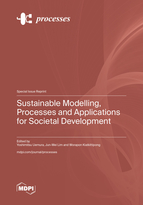Sustainable Modelling, Processes and Applications for Societal Development
A special issue of Processes (ISSN 2227-9717). This special issue belongs to the section "Sustainable Processes".
Deadline for manuscript submissions: closed (31 March 2022) | Viewed by 45316
Special Issue Editors
Interests: catalytic processes; reaction engineering; biomass conversion; renewable energy; nano and porous materials; STEM education
* worked in Universiti Teknologi Petronas from 2009 to 2019
Interests: wastewater treatment process
Special Issues, Collections and Topics in MDPI journals
Interests: process intensification; biorefinery; bioresources; biofuels
Special Issues, Collections and Topics in MDPI journals
Special Issue Information
Dear Colleagues,
The global society has experienced a tremendous development since the establishment of the first human civilizations, but no more so than in recent years, when societal development has further intensified thanks to the changes brought forth by the Fourth Industrial Revolution. Indeed, we are currently experiencing greater levels of energy, efficiency, productivity, comprehension, creativity, and innovation, all in our effort to continue on this path of significant scientific and industrial accomplishments. Societal development in particular is a continuous, unabated process, interlocking successive generations to one another. This development is necessary to achieve a decent quality of life; however, the rapid transformations we have experienced in the recent past must be accompanied by the exploration of sustainable approaches to them, and indeed, experts have sought to identify such approaches.
These approaches include modeling to deal with simulation, change of matter, time and space, analytical and statistical analyses, and real case studies for future prediction. The enhancement of all the processes currently used is undoubtedly essential to account for the escalation of various demands stemming from the population growth to the tune of approximately 10 billion by 2050. These processes include physical, biological, and chemical modes for sustainable technicality, treatment, bioremediation, control, production, and development, but also, and perhaps more importantly, applications corresponding to feedstock and products, new materials, operations, systems, theories on identifying and managing tangible and intangible resources, which are indispensable prerequisites in attaining sustainable societal development. Therefore, the prime intention of this Special Issue is to document novel “Sustainable Modeling, Processes, and Applications for Societal Development”. The knowledge gaps in the field of sustainability and societies must eventually be curtailed to create a global harmony whilst enriching the natural environments, and this is the purpose of this Special Issue.
Prof. Dr. Yoshimitsu Uemura
Dr. Jun-Wei Lim
Dr. Worapon Kiatkittipong
Guest Editors
Manuscript Submission Information
Manuscripts should be submitted online at www.mdpi.com by registering and logging in to this website. Once you are registered, click here to go to the submission form. Manuscripts can be submitted until the deadline. All papers will be peer-reviewed. Accepted papers will be published continuously in the journal (as soon as accepted) and will be listed together on the special issue website. Research articles, review articles as well as short communications are invited. For planned papers, a title and short abstract (about 100 words) can be sent to the Editorial Office for announcement on this website.
Submitted manuscripts should not have been published previously, nor be under consideration for publication elsewhere (except conference proceedings papers). All manuscripts are thoroughly refereed through a single-blind peer-review process. A guide for authors and other relevant information for submission of manuscripts is available on the Instructions for Authors page. Processes is an international peer-reviewed open access monthly journal published by MDPI.
Please visit the Instructions for Authors page before submitting a manuscript. The Article Processing Charge (APC) for publication in this open access journal is 1400 CHF (Swiss Francs). Please note that for papers submitted after 30 June 2020 an APC of 1500 CHF applies. Submitted papers should be well formatted and use good English. Authors may use MDPI's English editing service prior to publication or during author revisions.
Keywords
- simulation and modeling
- process control
- treatment
- medical technique
- material development
- clean energy
- water and wastewater
- IoT and AI
- Sustainable Development Goals
- education and policy








